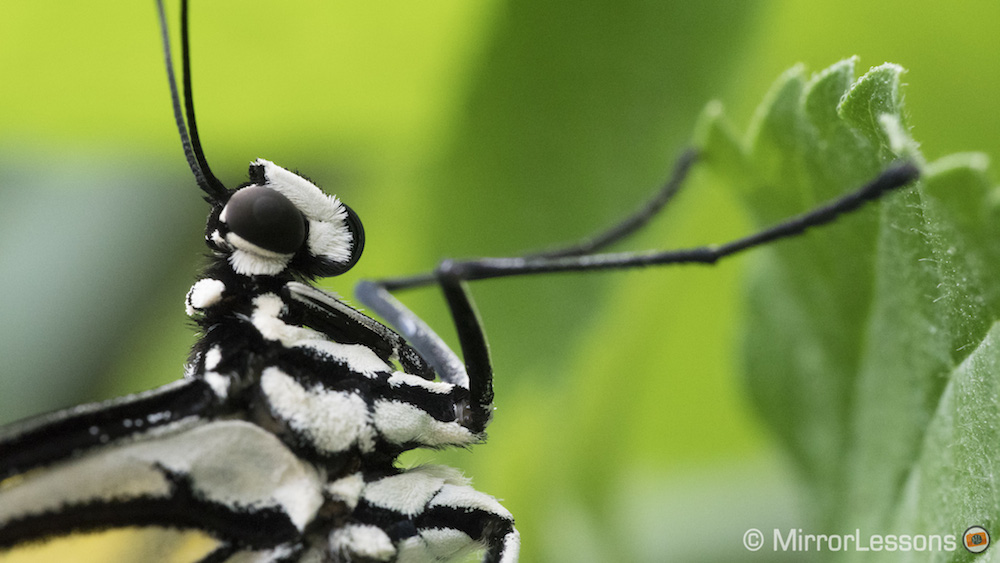Not too far from where we live, there is a small yet very well-presented butterfly house situated next to the Cwm Rheidol Reservoir, a mere 10 miles from Aberystwyth. Founded by Neil Gale in 2000, the butterfly house is home to over 80 species of butterfly, of which 30 can be seen at any one time during the year.
For my high ISO tests with the Sony a6300, the house proved the ideal location for a few different reasons.

- First, although the ceiling of the house is translucent, the high-reaching plants block much of the sunlight, especially on a cloudy day.
- Second, to photograph butterflies without the aid of a flash, you generally need a shutter speed of at least 1/200s, particularly with cameras that lack in-body stabilization like the a6300 or lenses that lack optical stabilization like the Touit 50mm, and slower aperture values to achieve a deeper depth of field.
- Finally, since butterflies are covered in fine hairs and scales, it was easy to see judge how much detail was being sacrificed by using the higher ISO values.
Photographing the butterflies
For my tests, I used the optically excellent Zeiss Touit 50mm f/2.8, a lightweight macro solution for APS-C E-Mount and Fuji X cameras. Our full Zeiss Touit 50mm review can be found here.
Note: In order for Touit lenses to be compatible with phase detection, they require a firmware update. The Fuji X-mount versions can be updated from Zeiss’ website but unfortunately the E-mount versions cannot. The lens needs to be sent to Zeiss for the update. If you are interested in this macro lens or any other Touit lens for the a6300 or a6000, it is best to ask the seller if it has the latest firmware or not prior to buying the lens.
I also limited myself to ISO speeds between 1280 and 51200 with varying apertures and shutter speeds. All shots were taken with the help of a monopod to counteract the lack of in-body stabilisation.

Overall, noise and detail retention in the RAW files remains acceptable up to ISO 6400, which falls in line with the results produced by the latest mirrorless cameras we’ve tested. At these values, it is easy to pick out the individual hairs on the butterflies’ bodies and the scales on their wings, and even the many minute ommatidia (light receptors) of their eyes when the focus is right.





At 12800, we see a decrease in detail and an increase in noise. The colours also appear flatter than at the lower values. This tendency continues until the highest value of 51200, which I consider completely unusable for any purpose since the excess noise blots out most of the fine detail.



A similar tendency can be observed from the JPGs with the difference you can adjust the Noise Reduction to High, Low or Off in the menu. I opted to use Low for the butterflies because High is far too aggressive and Off produces similar results to the RAW files.


As you can see, the Low setting does a good job of erasing most traces of noise but replaces it with a blotchy watercolour effect that destroys some of the fine detail. It is for this reason I prefer to use RAW files at the higher ISOs, not to mention that it is easier to recover the shadows and highlights in post-production.
How high can you go?
Since starting MirrorLessons and experimenting with many different camera models for a variety of genres, both Mathieu and I have found ourselves becoming more tolerant of noise at high ISOs. Sensors are so good these days that, as long as you don’t pixel peep at 100% or make large prints, noise and loss in detail aren’t as big an issue as they used to be.

A good example is the image below of the Tree Nymph butterfly. Despite having been taken at 25600 ISO, I don’t believe it would look out of place in a newspaper article or a small online image gallery promoting the butterfly house.

It would, however, be unacceptable as a full-page spread in a photography magazine or a large print in a gallery, as you can see from the crop below.

In the end, the ISO speed you choose will depend on a number of factors, from the subject and the light conditions to where the image will end up and your personal tolerance for noise and loss in detail.

In the case of macro photography, most photographers will use tripods to stabilise the camera, flashes to freeze the action and techniques such as focus stacking to increase the depth of field. For this reason, it is rare you’ll actually have to use very high ISOs out in the field.
Genres such as low-light sports, on the other hand, do require high ISOs because you’re dealing with fast-moving subjects and shutter speeds of at least 1/500s. For the image below, for example, I had no choice but to use 12800 ISO because I needed a speed of at least 1/800s to keep the players in focus and the lens’ fastest aperture was f/4.

How about you? What is the highest ISO speed you are comfortable using? Share your thoughts below!
Enjoyed this article? You may also like:
